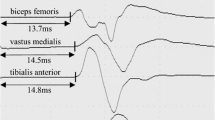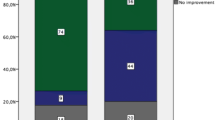Abstract
The aim of this clinical investigation was to determine whether the abnormal H-reflex complex present in patients with S 1 nerve root compression due to lumbosacral disc herniation is improved by single-session lumbar manipulation. Twenty-four patients with unilateral disc herniation at the L5-S1 level underwent spinal H-reflex electro-physiological evaluation. This was carried out before and after single-session lumbar manipulation in the side-lying position. Eligibility criteria for inclusion in the study were: predominant sciatica, no motor or sphincteric involvement, unilateral disc herniation at the L5-S1 level on CT or MR imaging, age between 20 and 50 years. H-reflex responses were recorded bilaterally from the gastrosoleous muscle following stimulation of tibial sensory fibers in the popliteal fossa. H-reflex amplitude in millivolts (HRA) and H-reflex latency in milliseconds (HR-L) were measured from the spinal reflex response. Pre- and post-manipulation measurements were compared between the affected side and the healthy side. Statistical evaluation was performed by the Wilcoxon matched-pairs test (SPSS). Thirteen patients displayed abnormal H-reflex parameters prior to lumbar manipulation, indicating an S1 nerve root lesion. The mean amplitude was found to be significantly lower on the side of disc herniation than on the normal, healthy side (P = 0.0037). Following manipulation, the abnormal HR-A increased significantly on the affected side while the normal HR-A on the healthy side remained unchanged (P = 0.0045). There was a significant difference between latencies on the affected side and those on the healthy side (P = 0.003). Following manipulation there was a trend toward decreased HR-L. However, this trend did not reach statistical significance (P = 0.3877). Eight patients displayed no H-reflex abnormalities before or after manipulation. Their respective HR-A and HR-L values did not change significantly following manipulation. Three additional patients were excluded due to technical difficulties in achieving manipulation or measuring spinal reflex. These observations may lend physiological support for the clinical effects of manipulative therapy in patients with degenerative disc disease.
Similar content being viewed by others
References
Baylan SP, Yu J, Grant AE (1981) H-reflex latency in relation to ankle jerk, electromyographic, myelographic and surgical findings in back pain. Electromyogr Clin Electrophysiol 21:201–206
Braddon RL, Johnson ER (1974) Standardization of H-reflex and diagnostic use in S1 radiculopathy. Arch Phys Med Rehabil 55:161–166
Braddon RL, Johnson ER (1974) H-reflex: Review and classification with suggested clinical use. Arch Phys Med Rehabil 55:412–417
Cramer GD, Humphreys CR, Hondras MA, McGregor M, Triano JJ (1993) The Hmax/Mmax ratio as an outcome measure for acute low back pain. J Manipulative Physiol Ther 16:7–13
Doran DML and Newell DJ (1975) Manipulation in the treatment of low back pain: a multicentric study. Br Med J 2:161–164
Garcia HA, Fisher MA, Gilai AN (1979) H-reflex analysis of segmental reflex excitability in flexor and extensor muscles. Neurology 29:984–991
Goldberg J, Sullivan SJ, Seaborne DE (1992) The effect of two intensities of massage on H-reflex amplitude. Phys Ther 72:449–457
Herdmann J, Dvorak J (1993) Electrophysiology of the normal and diseased spine. In: Floman Y, Farcy JPC, Argenson C (eds) Thoracolumbar spine fractures. Raven Press, New York, p 112
Hooper J (1973) Low back pain and manipulation: paraparesis after treatment of low back pain by physical methods. Med J Aust 1:549
Hugon M (1973) Methodology of the Hoffman reflex in man. In: Desmedt J (ed) New developments in electromyography and clinical neurophysiology, vol 3. Karger, Basel, pp 277–293
Murphy BA, Dawson NJ, Slack JR (1995) Sacroiliac joint manipulation decreases the H-reflex. Electromyogr Clin Electrophysiol 35:87–94
Paris SV (1983) Spinal manipulative therapy. Clin Orthop 179:55–61
Paris SV (1996) Manipulation of the lumbar spine. In: Weisel SW, Weinstein JN, Herkowitz H, Dvorak J, Bell G (eds) The lumbar spine. Saunders, Philadelphia, pp 1012–1017
Schuchmann JA (1978) H-reflex latency in radiculopathy. Arch Phys Med Rehabil 59:185–187
Sullivan SJ, Williams LR, Seaborne DE, Morelli M (1991) Effects of massage on alpha motomeuron excitability. Phys Ther 71:555–560
Wilson JN, Ifeld FW (1952) Manipulation of the herniated intervertbral disc. Am J Surg 83:173–175
Author information
Authors and Affiliations
Corresponding author
Rights and permissions
About this article
Cite this article
Floman, Y., Liram, N. & Gilai, A.N. Spinal manipulation results in immediate H-reflex changes in patients with unilateral disc herniation. Eur Spine J 6, 398–401 (1997). https://doi.org/10.1007/BF01834067
Received:
Revised:
Accepted:
Issue Date:
DOI: https://doi.org/10.1007/BF01834067




